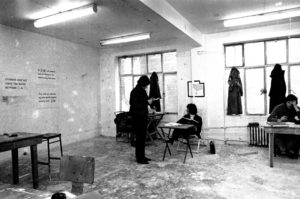
I teach a lot in small groups (‘basho’). The main teaching method is the crit (critique). This is akin to a counselling session wherein the basho focus intently on a student’s work, taking turns to become the focus of the discussion. For me this works best in a small group, rather than 1:1 since the basho are there to support the learning of their peers. Crits generally do not have an agreed or defined structure. There’s a lot of improvisation, much diversion and awkward silences. I like the sort of crits that have a (semi-)stucture that is designed by and agreed upon in advance by the participants. Working within a set of parameters makes the crit more playful, more ludic, and this can lead to greater insights. The parameters can be played with to produce different results (crit composition).
For example, in a paragogy the crit is steered by the student whose work is the focus. Staff and students have equal billing; there’s no facilitator.
Crits is often timed. The crit ends when the predetermined time-slot comes to an end (bit like a therapy session). This makes it a performative form of learning.
Crits can take place anywhere. They usually take place in front of a work of art. A work of art could be situated anywhere. Some crits are more abstract; focused on something at an earlier stage in development. This might not yet have any tangible form.
The image is of an infamous crit that took place at Central St. Martins School of Art during ‘Sculpture Course A’ wherein students were locked in the studio and not allowed to speak (a critique of the crit itself, which is supposed to be dialogual). This programme – devised by the artists Garth Evans, Gareth Jones and Peter Kardia – is a great influence on my approach to paragogy. I have recreated the Locked Room on many occasions, most recently at ECA. I’d highly recommend taking part in it.
